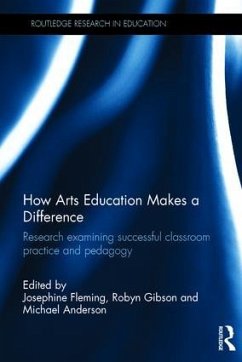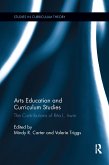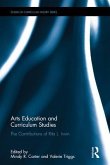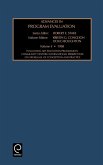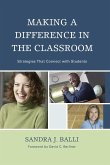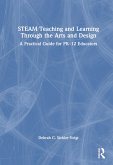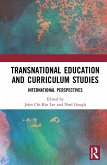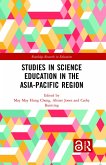How Arts Education Makes a Difference
Research examining successful classroom practice and pedagogy
Herausgeber: Fleming, Josephine; Anderson, Michael; Gibson, Robyn
How Arts Education Makes a Difference
Research examining successful classroom practice and pedagogy
Herausgeber: Fleming, Josephine; Anderson, Michael; Gibson, Robyn
- Gebundenes Buch
- Merkliste
- Auf die Merkliste
- Bewerten Bewerten
- Teilen
- Produkt teilen
- Produkterinnerung
- Produkterinnerung
Drawing on the findings of a longitudinal quantitative study led by the internationally renowned educational psychologist Andrew Martin, the book examines the impact of arts involvement in the academic outcomes of students and how it makes a difference in their lives. It reports on the in-depth qualitative research that investigates what constitutes best-practice in learning and teaching in the Arts. It also examines drama, dance, music, visual arts and film classrooms to construct an understanding of quality pedagogy in these classrooms.
Andere Kunden interessierten sich auch für
![Arts Education and Curriculum Studies Arts Education and Curriculum Studies]() Arts Education and Curriculum Studies57,99 €
Arts Education and Curriculum Studies57,99 €![Arts Education and Curriculum Studies Arts Education and Curriculum Studies]() Arts Education and Curriculum Studies195,99 €
Arts Education and Curriculum Studies195,99 €![Evaluating Art Education Programs in Community Centers Evaluating Art Education Programs in Community Centers]() K.G. Congdon / D. Boughton (eds.)Evaluating Art Education Programs in Community Centers169,99 €
K.G. Congdon / D. Boughton (eds.)Evaluating Art Education Programs in Community Centers169,99 €![Making a Difference in the Classroom Making a Difference in the Classroom]() Sandra J. BalliMaking a Difference in the Classroom53,99 €
Sandra J. BalliMaking a Difference in the Classroom53,99 €![STEAM Teaching and Learning Through the Arts and Design STEAM Teaching and Learning Through the Arts and Design]() Debrah C. Sickler-VoigtSTEAM Teaching and Learning Through the Arts and Design161,99 €
Debrah C. Sickler-VoigtSTEAM Teaching and Learning Through the Arts and Design161,99 €![Transnational Education and Curriculum Studies Transnational Education and Curriculum Studies]() Transnational Education and Curriculum Studies176,99 €
Transnational Education and Curriculum Studies176,99 €![Studies in Science Education in the Asia-Pacific Region Studies in Science Education in the Asia-Pacific Region]() Studies in Science Education in the Asia-Pacific Region176,99 €
Studies in Science Education in the Asia-Pacific Region176,99 €-
-
-
Drawing on the findings of a longitudinal quantitative study led by the internationally renowned educational psychologist Andrew Martin, the book examines the impact of arts involvement in the academic outcomes of students and how it makes a difference in their lives. It reports on the in-depth qualitative research that investigates what constitutes best-practice in learning and teaching in the Arts. It also examines drama, dance, music, visual arts and film classrooms to construct an understanding of quality pedagogy in these classrooms.
Produktdetails
- Produktdetails
- Verlag: Routledge
- Seitenzahl: 322
- Erscheinungstermin: 14. Dezember 2015
- Englisch
- Abmessung: 240mm x 161mm x 22mm
- Gewicht: 649g
- ISBN-13: 9781138845794
- ISBN-10: 1138845795
- Artikelnr.: 43920689
- Herstellerkennzeichnung
- Libri GmbH
- Europaallee 1
- 36244 Bad Hersfeld
- gpsr@libri.de
- Verlag: Routledge
- Seitenzahl: 322
- Erscheinungstermin: 14. Dezember 2015
- Englisch
- Abmessung: 240mm x 161mm x 22mm
- Gewicht: 649g
- ISBN-13: 9781138845794
- ISBN-10: 1138845795
- Artikelnr.: 43920689
- Herstellerkennzeichnung
- Libri GmbH
- Europaallee 1
- 36244 Bad Hersfeld
- gpsr@libri.de
Josephine Fleming researches and teaches in arts education and digital youth culture in the Faculty of Education and Social Work at the University of Sydney. Robyn Gibson is Associate Dean, Learning and Teaching and a Senior Lecturer in visual and creative arts in the Faculty of Education and Social Work at the University of Sydney. Michael Anderson is Professor (Arts and Creativity) in the Faculty of Education and Social Work at the University of Sydney.
Foreword Introduction - Do our schools need the arts? Part 1: Rationale for the Research 1.Introduction: Perceptions of the role of arts education within the academic context of Australian schools
Robyn Gibson 2.Negotiating arts education research
Michael Anderson 3.Arts and Cultural Policy in Australia
ARobyn Gibson
Josephine Fleming Part 2: Introducing the Research: Examining Mixed Methodologies 4.The project's research methods: Addressing gaps in previous arts research
Marianne Mansour
Andrew J. Martin
Gregory Arief D. Liem 5.Reading the intersection of combined quantitative and qualitative approaches
Josephine Fleming and Marianne Mansour 6.School
home
and community arts participation and students' outcomes: Quantitative findings
Marianne Mansour
Andrew J. Martin
Gregory Arief. D. Liem 7.The qualitative findings: Quality arts pedagogy
Robyn Gibson
Michael Anderson & Josephine Fleming Part 3: Understanding Successful Classroom Approaches 8.Understanding the social aesthetic
Caitlin Munday
Michael Anderson 9.The primary visual arts classroom: The imperative of narrative
Robyn Gisbon 10.The drama classroom: The practices of learning within community
Caitlin Munday
Josephine Fleming 11.Motivation and engagement in music: Theory
research
practice
and future directions
Andrew J. Martin
Rebecca J. Collie and Paul Evans 12.Arts education and school leadership: A case study
Josephine Fleming 13.Technology mediated arts engagement: Theoretical views
empirical bases
and applied implications
Gregory Arief D. Liem
Andrew J. Martin
Robyn Gibson Part 4: International Perspectives 14.The role of teaching frameworks: International perspectives on policy and arts education research
Robyn Gibson and Josephine Fleming with Pam Burnard
Ellen Shattuck Pierce and Steve Seidel
Janice Valdez and George Belliveau
Prue Wales and Chee Hoo Lum 15. (Re-)Positioning creativities in relation to effective arts pedagogy: UK perspectives on teaching for creativity and teaching creatively in the arts
Pamela Burnard 16.Perspectives on drama and performance education in canadian classrooms
George Belliveau
Monica Prendergast 17.Tracing arts education policy and practice in Singapore
Prue Wales
Chee Hoo Lum 18.Where to from here? Implications for future research
Michael Anderson
Robyn Gibson
Josephine Fleming
Robyn Gibson 2.Negotiating arts education research
Michael Anderson 3.Arts and Cultural Policy in Australia
ARobyn Gibson
Josephine Fleming Part 2: Introducing the Research: Examining Mixed Methodologies 4.The project's research methods: Addressing gaps in previous arts research
Marianne Mansour
Andrew J. Martin
Gregory Arief D. Liem 5.Reading the intersection of combined quantitative and qualitative approaches
Josephine Fleming and Marianne Mansour 6.School
home
and community arts participation and students' outcomes: Quantitative findings
Marianne Mansour
Andrew J. Martin
Gregory Arief. D. Liem 7.The qualitative findings: Quality arts pedagogy
Robyn Gibson
Michael Anderson & Josephine Fleming Part 3: Understanding Successful Classroom Approaches 8.Understanding the social aesthetic
Caitlin Munday
Michael Anderson 9.The primary visual arts classroom: The imperative of narrative
Robyn Gisbon 10.The drama classroom: The practices of learning within community
Caitlin Munday
Josephine Fleming 11.Motivation and engagement in music: Theory
research
practice
and future directions
Andrew J. Martin
Rebecca J. Collie and Paul Evans 12.Arts education and school leadership: A case study
Josephine Fleming 13.Technology mediated arts engagement: Theoretical views
empirical bases
and applied implications
Gregory Arief D. Liem
Andrew J. Martin
Robyn Gibson Part 4: International Perspectives 14.The role of teaching frameworks: International perspectives on policy and arts education research
Robyn Gibson and Josephine Fleming with Pam Burnard
Ellen Shattuck Pierce and Steve Seidel
Janice Valdez and George Belliveau
Prue Wales and Chee Hoo Lum 15. (Re-)Positioning creativities in relation to effective arts pedagogy: UK perspectives on teaching for creativity and teaching creatively in the arts
Pamela Burnard 16.Perspectives on drama and performance education in canadian classrooms
George Belliveau
Monica Prendergast 17.Tracing arts education policy and practice in Singapore
Prue Wales
Chee Hoo Lum 18.Where to from here? Implications for future research
Michael Anderson
Robyn Gibson
Josephine Fleming
Foreword Introduction - Do our schools need the arts? Part 1: Rationale for the Research 1.Introduction: Perceptions of the role of arts education within the academic context of Australian schools
Robyn Gibson 2.Negotiating arts education research
Michael Anderson 3.Arts and Cultural Policy in Australia
ARobyn Gibson
Josephine Fleming Part 2: Introducing the Research: Examining Mixed Methodologies 4.The project's research methods: Addressing gaps in previous arts research
Marianne Mansour
Andrew J. Martin
Gregory Arief D. Liem 5.Reading the intersection of combined quantitative and qualitative approaches
Josephine Fleming and Marianne Mansour 6.School
home
and community arts participation and students' outcomes: Quantitative findings
Marianne Mansour
Andrew J. Martin
Gregory Arief. D. Liem 7.The qualitative findings: Quality arts pedagogy
Robyn Gibson
Michael Anderson & Josephine Fleming Part 3: Understanding Successful Classroom Approaches 8.Understanding the social aesthetic
Caitlin Munday
Michael Anderson 9.The primary visual arts classroom: The imperative of narrative
Robyn Gisbon 10.The drama classroom: The practices of learning within community
Caitlin Munday
Josephine Fleming 11.Motivation and engagement in music: Theory
research
practice
and future directions
Andrew J. Martin
Rebecca J. Collie and Paul Evans 12.Arts education and school leadership: A case study
Josephine Fleming 13.Technology mediated arts engagement: Theoretical views
empirical bases
and applied implications
Gregory Arief D. Liem
Andrew J. Martin
Robyn Gibson Part 4: International Perspectives 14.The role of teaching frameworks: International perspectives on policy and arts education research
Robyn Gibson and Josephine Fleming with Pam Burnard
Ellen Shattuck Pierce and Steve Seidel
Janice Valdez and George Belliveau
Prue Wales and Chee Hoo Lum 15. (Re-)Positioning creativities in relation to effective arts pedagogy: UK perspectives on teaching for creativity and teaching creatively in the arts
Pamela Burnard 16.Perspectives on drama and performance education in canadian classrooms
George Belliveau
Monica Prendergast 17.Tracing arts education policy and practice in Singapore
Prue Wales
Chee Hoo Lum 18.Where to from here? Implications for future research
Michael Anderson
Robyn Gibson
Josephine Fleming
Robyn Gibson 2.Negotiating arts education research
Michael Anderson 3.Arts and Cultural Policy in Australia
ARobyn Gibson
Josephine Fleming Part 2: Introducing the Research: Examining Mixed Methodologies 4.The project's research methods: Addressing gaps in previous arts research
Marianne Mansour
Andrew J. Martin
Gregory Arief D. Liem 5.Reading the intersection of combined quantitative and qualitative approaches
Josephine Fleming and Marianne Mansour 6.School
home
and community arts participation and students' outcomes: Quantitative findings
Marianne Mansour
Andrew J. Martin
Gregory Arief. D. Liem 7.The qualitative findings: Quality arts pedagogy
Robyn Gibson
Michael Anderson & Josephine Fleming Part 3: Understanding Successful Classroom Approaches 8.Understanding the social aesthetic
Caitlin Munday
Michael Anderson 9.The primary visual arts classroom: The imperative of narrative
Robyn Gisbon 10.The drama classroom: The practices of learning within community
Caitlin Munday
Josephine Fleming 11.Motivation and engagement in music: Theory
research
practice
and future directions
Andrew J. Martin
Rebecca J. Collie and Paul Evans 12.Arts education and school leadership: A case study
Josephine Fleming 13.Technology mediated arts engagement: Theoretical views
empirical bases
and applied implications
Gregory Arief D. Liem
Andrew J. Martin
Robyn Gibson Part 4: International Perspectives 14.The role of teaching frameworks: International perspectives on policy and arts education research
Robyn Gibson and Josephine Fleming with Pam Burnard
Ellen Shattuck Pierce and Steve Seidel
Janice Valdez and George Belliveau
Prue Wales and Chee Hoo Lum 15. (Re-)Positioning creativities in relation to effective arts pedagogy: UK perspectives on teaching for creativity and teaching creatively in the arts
Pamela Burnard 16.Perspectives on drama and performance education in canadian classrooms
George Belliveau
Monica Prendergast 17.Tracing arts education policy and practice in Singapore
Prue Wales
Chee Hoo Lum 18.Where to from here? Implications for future research
Michael Anderson
Robyn Gibson
Josephine Fleming

